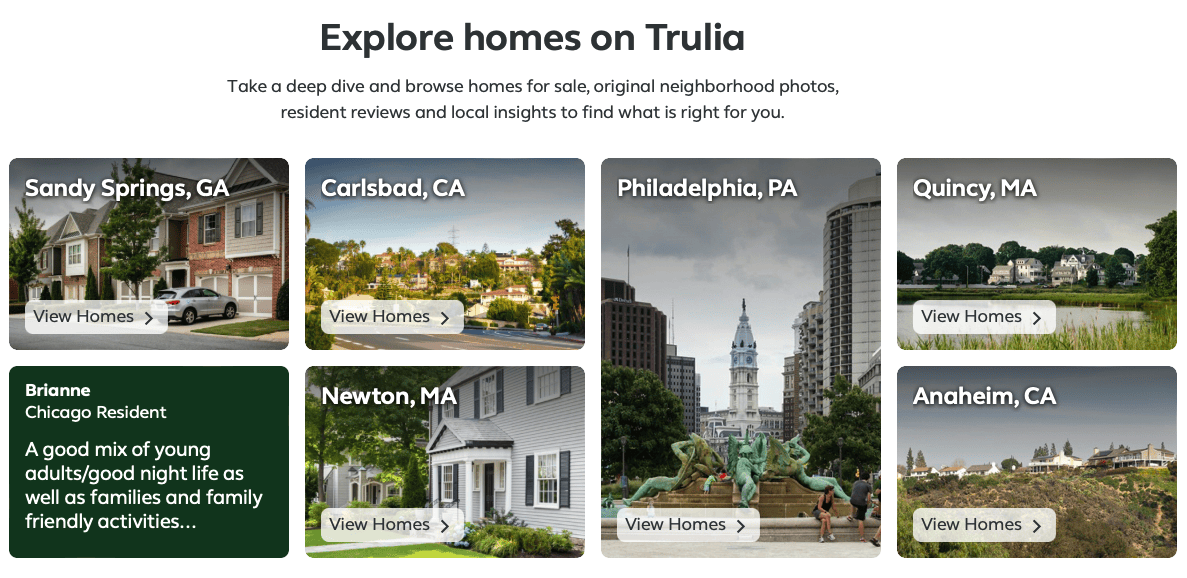What you'll learn:
➤ Zillow vs Trulia: A Quick Look
If you’ve ever tried to find a place to live or sell your home, you might have used Zillow or Trulia.
These websites help people find homes for sale or rent, and they can also connect you with real estate agents. The interesting thing is, they’re part of the same company now! Zillow bought Trulia in 2015 for a lot of money.
Both Zillow and Trulia show pictures of homes, a description of what they’re like, how much they cost, and info about the area they’re in. This info is pretty similar because they both use the same listings from real estate agents.
You can also search for homes using things like price, how many bedrooms they have, what type of building it is, how big it is, and how big the land around it is.
But even though they’re alike, they’re not the same. Zillow has something called “Zestimates,” which is their guess about how much a home is worth based on public info.
The way they show the homes is different too. On Zillow, when you look for homes in a city, you see the list of homes on the right and a map on the left. But on Trulia, it’s the other way around – the list is on the left, and the map is on the right.
We’ll talk more about this and the details of both websites next.
| Key Info to Consider |
|---|
| Zillow and Trulia are real estate databases that provide for-sale and rental listings and connect people with listing agents. 🏡🔍 |
| Zillow offers a visually rich experience for property searches, while Trulia has a simpler website design. 🌆🏠 |
| Zillow provides Zestimates—estimated property values—and lists properties in both the U.S. and Canada. 💰🇺🇸🇨🇦 |
| Trulia shows users the monthly costs for a property and includes crime map data for better insights. 💲🚓🗺️ |
| Both Zillow and Trulia have the same corporate owner since Zillow acquired Trulia in 2015. 🤝🏢 |
➤ Pros of Zillow & Trulia
| Zillow Pros | Trulia Pros |
|---|---|
| Provides a highly graphic experience for property searches. 🌆🏠 | Offers a simpler website design. 🏠 |
| Offers Zestimates—estimated market value for an individual property. 💰 | Gives a visual breakdown of monthly costs and crime map data. 💲🚓🗺️ |
| Lists properties in both the U.S. and Canada. 🇺🇸🇨🇦 | Lists properties only in the U.S. 🇺🇸 |
| Presents search results on the right and map on the left. 🔍🗺️ | Presents search results on the left and map on the right. 🔍🗺️ |
➤ Zillow
Zillow, born in 2006 and headquartered in Seattle, came into existence through the efforts of two former Microsoft executives, Rich Barton and Lloyd Frink.
Positioned as a leading real estate and rental marketplace, Zillow’s mission revolves around connecting consumers with essential information and real estate professionals to facilitate home buying, selling, and renting.

Remarkably, the platform boasts a staggering database of over 140 million properties, including those not actively listed on the market.
Zillow comes with the perk of being free for owners, listing agents, and landlords. The lion’s share of its revenue stems from advertising sales across its suite of sites: Zillow, Trulia, Hotpads, and more. This advertising space is sold to property management companies, mortgage lenders, and various other businesses.
Compared to its counterpart, Trulia, Zillow offers a significantly more visual user experience. The left side of the screen hosts a map displaying available properties fitting the chosen criteria in your search area.
Hovering over each property reveals a small thumbnail with key details like price, bedroom, and bathroom count.
The individual property listings, on the other hand, occupy the right-hand side of the screen, starting with the newest market entries. Information about a property is neatly compartmentalized:
- The left-hand side allows you to scroll through property photos and view enlarged versions of those that catch your eye.
- Top right corner showcases essential details like price, bedroom and bathroom count, square footage, and location.
- Just below, an overview section presents the property’s days on the site, view count, saves by other users, and a detailed realtor-provided description encompassing the property’s features, community insights, and neighboring homes.
- The “Contact” button facilitates instant connection with the listing’s realtor or responsible individual through messaging.
One of Zillow’s unique offerings is its Zestimates, estimating a property’s market value. However, Zestimates are a starting point, not an official appraisal. These values are calculated daily using data from public sources and users.
Furthermore, Zillow’s Zestimate forecast predicts the home’s price a year ahead, relying on current market and home information.
Stay informed about real estate trends and research using Zillow’s research tab. Segmented into categories like news, data, markets, buying and selling, renting, and market policies, this section keeps you in the know.
Take note, though, that Zestimates have their accuracy limits. While Zestimates for homes on sale have a median error rate of 3.2%, those for off-the-market homes have a higher rate, around 7.52%. Remember, these figures are from Zillow and should be taken with a pinch of skepticism.
➤ Trulia
Trulia, established in 2005 and headquartered in San Francisco, stands tall as another well-known player in the real estate website landscape.
Much like its counterpart Zillow, Trulia steps in with a wealth of real estate listings catering to potential home buyers, sellers, and renters. In line with the norm, Trulia’s revenue stream flows largely from advertising endeavors.

Despite its ownership now being under the Zillow umbrella, Trulia offers a distinctive online experience for its users. Search results unveil a map on the right-hand side while property listings grace the left.
Clicking on a specific listing opens up the essential details—price, address, bedrooms, bathrooms, square footage—located at the top. Additionally, an estimate of the monthly mortgage payment accompanies these particulars.
Further down the page, you’ll discover property photos and listing information, complete with realtor contacts. This segues into an in-depth property description provided by the listing agent, spotlighting features and similar residences in the vicinity.
While both Zillow and Trulia are equipped to estimate a home’s value, it’s crucial to note that these estimations cannot replace the expertise of a professional home appraisal. These estimates provide a starting point, but the full picture requires the insights of a seasoned professional.
➤ Zillow vs Trulia: Comparison
Despite sharing the same ownership, Zillow and Trulia exhibit distinct differences. Zillow boasts a more international scope compared to Trulia, as it lists homes not only across the United States but also in various Canadian cities.
The variance extends to their methods of estimating home prices. Zillow’s “Zestimate” claims an accuracy level within 3.2% for homes on the market, relying on a proprietary formula that taps into public and user-generated data.
The Trulia Estimate stems from the Zestimate but factors in other variables as well. Going a step further, Trulia equips users with 34 neighborhood map overlays, offering deeper insights into the living experience of a home and its surroundings.
Delving into affordability, Trulia offers a compelling feature—a visual breakdown of monthly costs. This encompasses the mortgage payment, property taxes, home insurance, association fees, and mortgage insurance.
This breakdown aids potential buyers in gauging whether a specific dwelling fits their financial comfort zone.
Trulia’s distinct offerings also extend to safety concerns with its crime map data. The platform aggregates crime information from local law enforcement and news sources, enabling users to gauge the security status of the neighborhood.
➤ Competitors
Zillow’s acquisition of Trulia undoubtedly solidified its supremacy in the real estate search arena. Yet, a host of smaller contenders, including Redfin, Homesnap, and Realtor.com, continue to enrich the market with similar functionalities.

Interestingly, some of these rivals might even bring to the table additional perks not found on Zillow or Trulia.
Take Redfin, for instance. This platform sets itself apart by harnessing a team of real estate agents whose compensation hinges on their user ratings. This unique approach aligns incentives, motivating Redfin agents to actively match homeowners and potential buyers for an optimal pairing.
On another front, Foreclosure.com enters the scene with a specific focus on the most budget-conscious individuals. Geared towards economical homes, this site serves as a go-to hub for users scouring the internet for homes currently under foreclosure.

While the purchase of foreclosed properties carries its share of risks, the potential savings can prove compelling for prudent investors.
➤ Zillow vs Trulia FAQ
| Question | Answer |
|---|---|
| What’s the Difference Between Zillow and Trulia? | Although under the same corporate umbrella, Zillow and Trulia sport diverse interfaces. Zillow offers a more graphic home search experience, while Trulia adopts a simpler design. Zillow’s reach extends beyond the U.S., featuring listings for Canadian cities too. 🌍🏠 |
| How to List a Home on Zillow and Trulia? | Listing on either platform starts with creating a Zillow account and claiming your home by address search. Set the price, upload photos, provide details, and submit the listing for approval. Within about 24 hours, the listing appears on Trulia as well. 🏡✍️ |
| How Accurate Are Zillow and Trulia Estimates? | Both platforms employ sophisticated algorithms, factoring in location, size, neighborhood data, and nearby property sales for their estimates. However, like any algorithms, they can vary in accuracy. For precise pricing, consult a professional appraiser. 📈🔍 |
| Zillow vs Trulia: Verdict | Zillow and Trulia rank among the top real estate websites. Given Trulia’s ownership by Zillow, both sites share listings and property details. The choice hinges on desired user experience and features. 🏆🏠🔍 |



